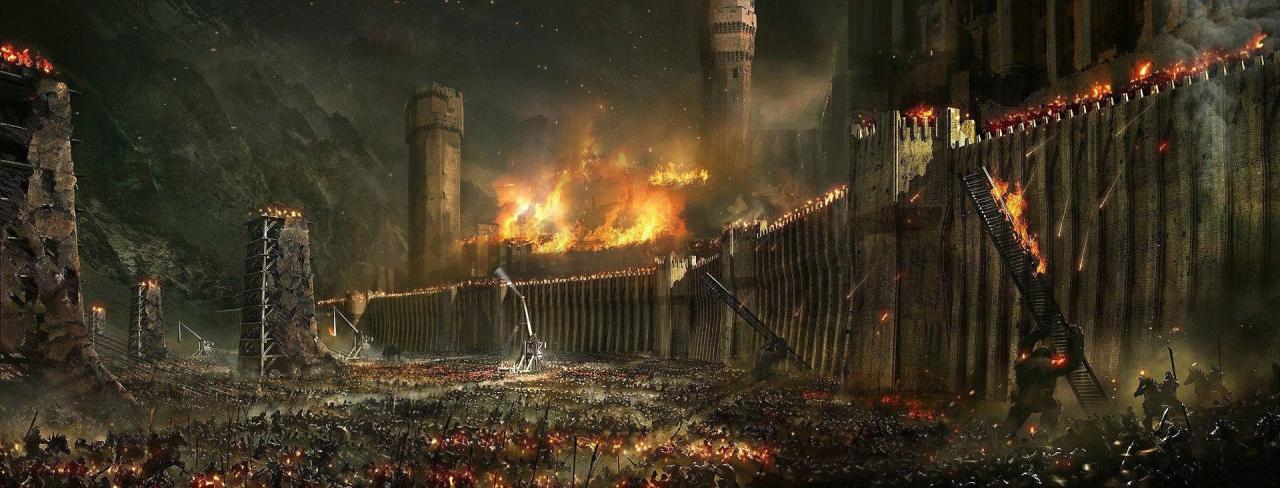
The Battle of Helm’s Deep is one of the most iconic and climactic scenes in J.R.R. Tolkien’s epic fantasy, “The Lord of the Rings.” This fictional battle serves as a pivotal moment in the struggle against the dark forces led by Saruman, showcasing themes of bravery, unity, and the enduring struggle between good and evil. Set against the backdrop of Middle-earth, Helm’s Deep epitomizes the resilience of the free peoples of Middle-earth as they confront overwhelming odds.
Helm’s Deep is a fortress located in the valley of the White Mountains, designed as a refuge for the people of Rohan during times of war. In Tolkien’s narrative, the battle is precipitated by Saruman’s relentless desire for power, as he seeks to dominate Middle-earth by aligning himself with Sauron. The tension escalates when Saruman unleashes his army of Uruk-hai, a brutal and savage breed of Orcs, to attack Rohan, leading to the desperate defense of Helm’s Deep.
The significance of the battle is not only in its sheer scale but also in its representation of unity among various factions in Middle-earth. King Théoden of Rohan, portrayed as a once-great leader who has been weakened by despair, rises to the occasion. With the guidance of Aragorn, Legolas, and Gimli, the defenders rally together to protect their home. This coalition symbolizes hope and the collective strength of humanity when facing darkness.
The battle itself is a masterclass in tension and drama. Tolkien vividly describes the overwhelming force of the Uruk-hai, who are equipped with siege weapons and relentless in their pursuit of conquest. The defenders, though outnumbered and beleaguered, display extraordinary courage and resourcefulness. The clash of steel, the roar of battle cries, and the cries of the wounded paint a harrowing picture of war that resonates with readers and viewers alike.

One of the most notable elements of the Battle of Helm’s Deep is the arrival of the Huorns, tree-like beings that are closely associated with the Ents. This unexpected turn in the battle demonstrates the interconnectedness of the natural world and the forces of good. The Huorns, representing the ancient power of nature, rise to protect the people of Rohan, striking a decisive blow against Saruman’s forces. Their intervention is a powerful reminder of the alliance between the free peoples and the natural world, highlighting themes of stewardship and respect for nature.

Tolkien’s detailed world-building shines in this battle, as he masterfully conveys the stakes involved. The narrative captures the desperation of the defenders and the relentless assault by Saruman’s army, creating an atmosphere of impending doom. Yet, it also celebrates acts of heroism and sacrifice, showcasing characters who rise to the occasion. For instance, Éowyn, a key character in the story, embodies the strength and resilience of Rohan’s women, challenging traditional gender roles in her quest for valor.

The aftermath of the Battle of Helm’s Deep is equally significant, as it sets the stage for the larger conflict in Middle-earth. While the battle is hard-fought, it ultimately serves as a turning point in the War of the Ring. The unity forged in the heat of battle strengthens alliances, paving the way for the eventual confrontation with Sauron’s forces.
In conclusion, the Battle of Helm’s Deep is not just a battle; it is a representation of hope, unity, and the enduring struggle against evil. Through his vivid storytelling, Tolkien immerses readers in a world where courage and sacrifice are paramount. The battle serves as a powerful reminder that, even in the darkest of times, the spirit of fellowship and the resilience of the human heart can lead to victory. As fans of “The Lord of the Rings” continue to engage with this timeless tale, the Battle of Helm’s Deep remains a compelling symbol of the fight for good in a world fraught with danger and darkness.
